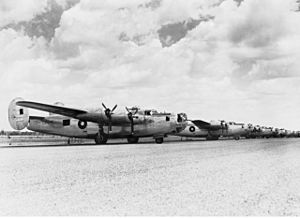Fenton Airfield facts for kids
Fenton Airfield was an important military airfield in the Northern Territory of Australia. It was built during World War II and named after Flight Lieutenant Clyde Fenton. You can find it today in the area known as Douglas-Daly.
This airfield was abandoned in 1945 after the war ended. It is one of only three large bomber airfields from World War II that still exist in the Katherine–Darwin region. Today, Fenton Airfield is open to visitors. You can walk on the main runway and see parts of the old control tower. You might even find pieces of old aircraft scattered around!
Contents
Building Fenton Airfield
Work on Fenton Airfield began on April 27, 1942. It was built by the 808th Engineer Aviation Battalion. The first runway was about 6,000 feet (1,829 meters) long and 100 feet (30 meters) wide.
Later, the Royal Australian Air Force (RAAF) and the New South Wales Department of Main Roads helped make the airfield bigger. The runway was extended to about 7,218 feet (2,200 meters) long. It also had nearly 60 places for aircraft to park, some with protective dirt walls called revetments.
The airfield was named after Flight Lieutenant Clyde Fenton. He was an RAAF officer who suggested this location for the airfield.
Fenton Airfield's Role in World War II
Fenton Airfield was mostly used by large Liberator bomber planes. These planes flew long missions to attack Japanese forces. Their targets were in places like the Netherlands East Indies and other parts of the South West Pacific Area.
During the war, Fenton Airfield was a busy place. It served as a main base for both Australian and United States air force units. Planes from Fenton flew reconnaissance missions over Timor Island, New Guinea, and the Celebes Islands. They also carried out attacks on Japanese airfields, ground bases, and ships.
One famous mission happened on February 29, 1944. The USAAF 380th Bombardment Group flew a 16-hour mission from Fenton to Borneo. This was a very long flight, covering over 2,500 nautical miles (4,630 kilometers).
After the War
Fenton Airfield was no longer needed when World War II ended in 1945. Over time, nature has taken back much of the land. Most of the buildings are gone now. You can still see concrete foundations, piles of rubble, and sometimes old aircraft parts.
From the air, you can faintly see where some roads used to be. These roads likely led to different parts of the base, like where bombs were stored or administrative offices. However, no actual buildings remain standing.
Fenton Airfield is an important historical site. It was listed on the Northern Territory Heritage Register on September 11, 1996.
Military Units at Fenton Airfield
Many different military units used Fenton Airfield during World War II. These included groups from both the Royal Australian Air Force (RAAF) and the United States Army Air Forces (USAAF).
Some of the RAAF units based here were:
- No. 1 Airfield Construction Squadron RAAF (they helped build and maintain the airfield)
- No. 6 Repair and Salvage Unit RAAF (they fixed damaged planes)
- No. 21 Squadron RAAF (flew B-24 Liberator bombers)
- No. 23 Squadron RAAF (flew B-24 Liberator bombers)
- No. 24 Squadron RAAF (flew B-24 Liberator bombers)
- 82nd Wing RAAF (this wing included Squadrons 21, 23, and 24)
United States Army Air Forces (USAAF) units included:
- 64th Bombardment Squadron (flew B-17 Flying Fortress bombers)
- 319th Bombardment Squadron (flew B-24 Liberator bombers)
- 380th Bombardment Group (flew B-24 Liberator bombers)
Other units included the 808th Engineer Aviation Battalion and the 133 Heavy Anti Aircraft Battery of the Australian Army.
Japanese Attacks on Fenton Airfield
Fenton Airfield was a target for Japanese forces during the war. It was bombed several times:
- June 30, 1943 (12:30 pm)
- July 6, 1943 (12:02 pm)
- August 13, 1943 (9:45 pm and 11:12 pm)
- August 21, 1943 (3:07 am)
- September 15, 1943 (12:25 am)
- September 18, 1943 (3:50 am)



